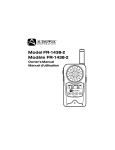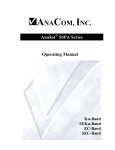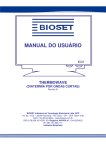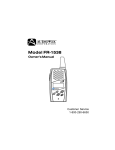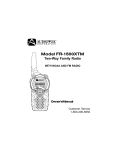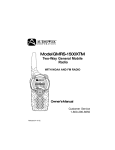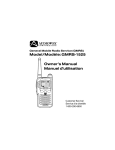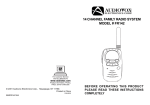Download Audiovox FR-1438-2 Owner`s manual
Transcript
Model FR-1438-2 Owner’s Manual F FR1438-2 5 3 4 7 PTT M 2 8 11 13 F 1 10 9 1. 2. 3. 4. 5. 6. 7. 8. 9. 10. 11. 12. 13. FR1438-2 12 Battery Door Monitor Button Detachable Belt Clip Push-To-Talk (PTT) Button Antenna External Speaker Jack Built-in Speaker Liquid Crystal Display (LCD) Built-in Microphone Up Button and Volume Control Down Button and Volume Control Function Button Power On/Off and ENTER Button 2 6 Model FR1438-2 DISPLAY 1, 2 3 4 5 6 7 8 9 10, 11 12 13 14 1. 2. 3. 4. 5. 6. 7. 8. 9. 10. 11. 12. 13. 14. 15 RSSI Indicator: Receive signal strength indicator. TX: Icon blinks during transmission. Monitor Indicator: Icon appears when the monitor button is pressed. Coded Tone Controlled Squelch System (CTCSS) Indicator: Icon appears when receiving a transmission with correct CTCSS tone. Auto Scan Indicator: Icon appears when the auto scan channel mode is activated. Dual Watch Scan Indicator: Blinks in dual watch scan mode or when the dual watch scan mode is activated. Voice Activated Transmission (VOX) Indicator: Blinks in the VOX selection mode or appears when VOX is activated. Key Lock Indicator: Blinks in autolock selection mode or appears when the key lock is activated. Call Indicator: This icon blinks in call selection mode and appears when the unit is transmitting the call tone. Battery Level Indicator: Icon indicates the battery charge strength. Power Saver Indicator: Icon blinks to indicate the power saver is activated. The rate at which the icon blinks varies with the power saving ratio. Fast blinking indicates a lower power saving while slow blinking indicates a higher power saving ratio. TX Indicator: Icon appears when a signal is being transmitted. RX Indicator: Icon appears when a signal is being received. Large Segment Display: Indicates the channel number in use in normal mode. When the Function Button is pressed, the FR1438-2 menu is displayed in sequence. 3 CH Channel select mode (1-14) ctc Coded Tone Controlled Squelch System Sub-Channel Select Mode SC Auto Channel Scan Mode Dual Channel Watch Mode d UO Voice Activated Function Udt Voice Activated Recovery Time ALO Auto Key Lock Selection Mode CAL Call Ringer Melody Selection Mode ton Sub-Channel Number or Sub-Channel Frequency 15. Small Segment Display: Displays the CTCSS tone option in the normal mode. The CTCSS option is shown in Hz. When the Function Button is pressed, the FR1438-2 selection of each menu is displayed in the following sequence and format. (1 through 14) (CH) Channel Number (1 through 38 or Frequency, OFF) (cTc) Sub-Channel Frequency in Hertz or Number (Up, Down, OFF) (SC) Auto Channel Scan Mode (Channel Number 1 through 14, OFF) (d ) Dual Channel Watch Mode (High,Off, Low) (UO) Voice Activated Function (Choice of 5,3,2,1 seconds) (Udt) Voice Recovery Activated Time (Off, Auto) (ALO) Auto Key Lock Selection Mode (1 Through 7) (CAL) Call Ringer Melody Selection (Number) or (Hertz) (ton) Sub-Channel Frequency (Number = no, Frequency = Freq) Powering the transceiver: Your FR1438-2 radio transceiver operates on four AAA batteries . You may operate your FR1438-2 using the rechargeable batteries included or you may use alkaline batteries. Alkaline batteries will provide slightly better performance than the rechargeable batteries, but must never be recharged in the charging stand. Installing the batteries: To install batteries into the radio, it is necessary to remove the belt clip. To do this you will need to release the spring clip securing the belt clip to radio and lift the belt clip away from the radio body. Next, remove the battery compartment cover by sliding it downward towards the bottom of the transceiver. Observe the polarity symbols on the bottom of the tray when inserting the batteries. Replace the cover. 4 SPRING CLIP BATTERY COVER SIZE AAA AAA SIZE 1. Press the spring clip 2. Slide the battery cover 3. Insert batteries observing and slide the belt clip downward. the polarity symbols on upwards. the bottom of the tray. The following guidelines will improve performance and provide longer operating times for the FR1438-2: 1. Do not mix old and new batteries. 2. The use of alkaline-type batteries is recommended to provide the longest operating time. 3. Do not mix alkaline, standard (carbon-zinc) or rechargeable (Ni-MH) batteries. 4. If the unit is not to be used for an extended period of time, remove the batteries. Old or leaking batteries can cause damage to the unit and will void the warranty. Wrist Strap and Detachable Belt Clip Installation The wrist strap and detachable belt clip are provided to enable you to carry the FR1438-2 easily and safely. The wrist strap can be attached to the hole located on the top of the belt clip. Feed the small loop on the end of the strap through the hole and then pass the strap through the loop and pull tight. The detachable belt clip fits into the slot located on the rear of the unit. To remove the belt clip, press the locking clip at the top of the belt clip away from the unit and slide the belt clip upwards. To install the belt clip slide it down into the slot and snap in to place. 5 Charging the FR1438-2: Insert the charging transformer into a household electrical outlet and connect its power jack to the socket on the rear of the charging stand. Simply placing the unit into the charging stand will begin the charging process. The red LED on the front of the charging transformer serves as a charge indicator. The charging stand will charge two units simultaneously. Approximately 12 – 16 hours are required to fully charge the batteries. Remember to turn your FR1438-2 OFF before placing it into the charging stand. Caution: The charging stand in your kit is intended for use with the supplied batteries. Do not attempt to recharge any other batteries with the charging stand. CHARGING STAND TRANSFORMER CONNECTOR CHARGING TRANSFORMER RED LED CHARGING INDICATOR Controls: Power On/Off (13): Press and hold this button for two seconds to turn the unit on. A short confirming melody will sound. To turn the unit off, press and hold the button for a two-second period. A short tone will sound before the unit shuts off. Enter Button (13): This button is also used to confirm options for operating modes during the function edit mode. A momentary press of this button will convert the display of the CTCSS subcode from a frequency to a number or number to a frequency for two seconds. 6 Push To Talk (PTT) Button (4): Pressing and holding this button will allow you to speak to any transceiver that is set to the same channel and privacy code setting as yours. Hold the transceiver approximately 1 to 2 inches from your face as you speak into the built in microphone (9). After you have finished speaking, release the PTT button to allow the reception of incoming signals. It is not possible to transmit and receive at the same time. The red transmit LED indicator located on the right side of the LCD Panel (8) will light while the PTT button is pressed. Releasing the button allows the unit to revert to standby mode. When receiving an incoming signal, the green receive LED indicator on the left side of the LCD Panel (8) will light. The PTT button can also be used as a two-way call ringer. Pressing the button twice quickly will call another party on the same channel. The word CALL and the transmit icon will appear in the display. The user selected call will sound. Volume Control (10 and 11): In the standby mode, adjust the volume to a comfortable level by presing the Up (10) to increase the volume level and the Down (11) to decrease the volume level. Up Button (10): In the standby mode, pressing this briefly will increase the volume. In the function edit mode, pressing the button briefly will shift from the current option in each submenu to next option in the same submenu. Pressing the button for more than 1.5 seconds allows navigation at a more rapid rate. In the standby mode the volume will increase rapidly. In the function mode, different menus can be rapidly accessed. Down Button (11): In the standby mode, pressing this briefly will decrease the volume. In the function edit mode, pressing the button briefly will shift from the current option in each submenu to next previous option in the same submenu. Pressing the button for more than 1.5 seconds allows navigation at a more rapid rate. In the standby mode the volume will decrease rapidly. In the function mode, different menus can be rapidly accessed. 7 Function Button (12): In the standby mode, pressing this button briefly will enter the function edit mode. Pressing the button for more than 1.5 seconds will activate or deactivate the KEY LOCK when the unit is in the standby mode. Refer to KEY LOCK function description to activate and deactivate the KEY LOCK. NOTE: All buttons will be disabled except for the Monitor Button (2) and the PTT Button (4). Monitor Button (2): The Monitor Button is used to check the activity on a channel before transmitting. When the Monitor Button is pressed, the LCD panel (8) will light and both the transmit and the receive indicators will light. Pressing the Monitor Button during the edit function mode will return the unit to standby. Pressing the Monitor Button during a VOX tranmission (voice activated transmission) will discontinue the transmission and disable the VOX function for ten seconds. External Microphone/Speaker (6): This jack accepts an Audiovox FRS-BHST headset/microphone for totally hands free operation. Operating Modes and Features Channel Select Mode: This feature allows the selection of main channels for communication. 1. Press the Function Button (12) until CH appears in the LCD Panel (8). 2. Press the Up Button (10) or the Down Button (11) to choose the channel. 3. Press the Enter (13) to confirm your selection. Coded Tone Controlled Squelch System (CTCSS): When the CTCSS feature is on the transceiver will only receive signals from other transceivers set to the same channel and privacy code. When the CTCSS mode is off, the transceiver will receive signals from all transceivers set to the same channel. Remember that the CTCSS feature does not prevent others from listening to your transmissions. It only allows your FR1438-2 to ignore signals from transceivers not set to the same privacy code. 1. Press the Function Button (12) until ctc appears in the LCD Panel (8). 2. Press the Up Button (10) or the Down Button (11) to choose the CTCSS code desired. 3. Press the Enter (13) to confirm your selection. 8 NOTE: To communicate with other units, they must be switched to the same channel and CTCSS subcode. To communicate with other units that do not have subcodes, switch your unit to the same channel with the subcode set to Off. AUTO CHANNEL SCAN MODE: This feature allows scanning for an active channel. The volume cannot be adjusted and the power saver is disabled in this mode. To access the Auto Channel Scan menu: 1. Press the Function Button (I 2) until the auto channel icon blinks and SC appears in the LCD Panel (8). 2. Press the Up Button (10) or the Down Button (11) to choose scanning up or down from the current channel number. 3. Press the Enter Button (I 3) to confirm your selection. The unit will begin scanning for an active main channel. If a transmission is detected, the Receive and RSSI icons will appear in the LCD Panel (8). To turn off the auto channel scan feature in the standby mode, simply press the Function Button (12) once. You can pause on any channel while in the Auto Channel Scan Mode by pressing the PTT Button (4) during the reception of a signal for 5 seconds afterward. Pressing the Monitor Button (2) will resume scanning and eliminate that channel from those being scanned. DUAL WATCH SCAN MODE This feature allows the monitoring of two different channels at the same time. If any priority channel other than the current channel in use is preset, the preset channel will be scanned every 0.5 second and you will signaled when a call is received. While in the Dual Watch Scan Mode you may hear transmissions from either a primary or secondary channel when transmitting. The unit will always transmit on the primary channel unless the PTT Button (4) is pressed during or immediately following the reception of secondary channel transmission. The power saver mode is disabled in the Dual Watch Scan Mode and the volume is not adjustable. To access the Dual Watch Scan menu: 1. Press the Function Button (12) until the dual watch icon blinks and d appears in the LCD Panel (8). 2. Press the Up Button (10) or the Down Button (II) to select the desired channel number you wish to monitor. 3. Press the Enter Button (13) to confirm your selection. 9 To turn off the dual watch feature in the standby mode, simply press the Function Button (12) once. VOX SELECTION MODE The Voice Activated Transmission (VOX) function allows your voice to activate signal transmission automatically when the FR1438-2 is used with a hands free microphone/ headset (FRS-BHST). It also allows hands free use when a microphone/headset is not being used without having to use the PTT Button (4). When in the VOX mode a short beep will sound after the termination of any VOX generated transmission. To access the VOX Selection menu: 1. Press the Function Button (12) until the VOX icon blinks and UO appears in the LCD Panel (8). 2. Press the Up Button (10) or the Down Button (11) to select from high, low or off. The high or low setting determines VOX response sensitivity. 3. Press the Enter Button (13) to confirm your selection. VOX RECOVERY TIME SELECTION MODE This allows the setting of the transmit delay after you have finished speaking. To access the VOX Recovery Time Selection menu: 1. Press the Function Button (12) until Udt appears in the LCD Panel (8) with the VOX icon blinking. 2. Press the Up Button (10) or the Down Button (11) to select from the 5, 3, 2 or 1 second setting. This setting determines the delay time between transmitting and receiving. 3. Press the Enter Button (13) to confirm your selection. NOTE: You may need to try different VOX time settings to determine the best value to suit your speaking habits. To turn off the VOX feature, enter the VOX selection mode and then select OFF. AUTO KEY LOCK SELECTION MODE This feature prevents accidental channel change and disturbance to the preferred settings of the FR1438-2. The Auto Key Lock feature temporarily disables the Up, Down and Enter Buttons. To access the Auto Key Lock Selection menu: 1. Press the Function Button (12) until the auto lock icon blinks and ALO appears in the LCD panel (8). 10 2. Press the Up Button (10) or Down Button (11) to select the Auto option. 3. Press the ENTER key to confirm your selection. If you do not press any key for more than 15 seconds in the standby mode, keys will automatically be locked except the PTT (4) and monitor (2) buttons. To turn the auto key lock on or off in standby mode, simply press and hold the Function Button (12) for more than 1.5 seconds. To quickly activate the Key Lock, hold the Function Button (12) for more than 1.5 seconds. CALL MELODY SELECTION MODE This feature provides seven user selectable call ringer melodies that alert the user that a calling party wishes to communicate with them. Once the melody is chosen, double pressing the PTT Button (4) twice within one second will transmit the tone selected. To select your favorite Call Ringer melody: 1. Press the Function Button (12) until the call icon blinks and CAL appears in the LCD panel (8). 2. Press the Up Button (10) or Down Button (11) to preview the seven available melodies. 3. Press the ENTER key to confirm your selection. CTCSS SUB CODE DISPLAY SELECTION MODE To select your favorite CTCSS sub code display: 1. Press the Function Button (12) until Ton appears in the LCD panel (8). 2. Press the Up Button (10) or Down Button (11) to select the tone in Hertz or the tone ID number. 3. Press the ENTER key to confirm your selection. NOTES FOR GOOD COMMUNICATION 1 . The FR1438-2 14 channels are shared on a ‘take turns’ basis. This means other groups may be talking on any of the channels. A common code of ethics/courtesy is to switch to another vacant channel and not to attempt to talk over someone who is already using the channel you first selected. 2. The FR1438-2 has been designed to maximize performance and improve transmission range in the field. To avoid interference, it is recommended that you do not use the units closer than 5 feet apart. 3. For best transmission results, always keep your mouth about 2-3 inches from the microphone (9) and speak slowly in a normal voice. 11 Warning • Remove the batteries from the transceiver if it is not expected to be used for long periods. This will eliminate the possibility of chemicals leaking from the batteries and corroding the transceiver. • Avoid exposing the transceiver to water or extremes of temperature. • Do not use this device in or near a mining facility, which uses remotely triggered explosives or in areas labeled “Blasting Area”. Premature or accidental detonation may result. • Do not attempt to modify or in any way increase the output of this transceiver. Its output is designed to meet the legal limits set by the F.C.C. • Do not use this device or change its batteries in potentially explosive atmospheres as sparks in such areas could result in an explosion. • Turn your transceiver off wherever posted notices restrict the use of radios or cellular telephones. Facilities such as hospitals may use equipment that is sensitive to RF energy. • Turn your transceiver off on board aircraft when requested to do so. • Do not place your radio in front of a vehicle’s air-bag. If the air-bag deploys, it could propel the transceiver like a projectile causing bodily injury. This transceiver complies with F.C.C. regulations for use in the United States of America. Use in other countries may be prohibited or restricted by local regulation. Please check with the local regulating agency before using this device outside the United States of America. Main Channel Frequencies: Channel 1 2 3 4 5 6 7 Freq. MHz 462.5625 462.5875 462.6125 462.6375 462.6625 462.6875 462.7125 Channel 8 9 10 11 12 13 14 12 Freq. MHz 467.5625 467.5875 467.6125 467.6375 467.6625 467.6875 467.7125 Troubleshooting Problem Possible cause Correction No transmission while pressing the PTT button Weak batteries Incorrect battery Polarity Charge or replace batteries Install the batteries in the directions indicated by the battery tray. Weak or no signal received Weak batteries Channel and privacy code not set the same as target transceiver Volume level too low PTT button inadvertently depressed Excessive radio interference on a particular channel Obstruction of radio signal Charge or replace batteries Adjust the transceiver’s settings to match those settings of the target transceiver Increase volume level Release PTT button Change to a different channel Avoid operating in or near large buildings or vehicles Transceiver beeps, but will not turn on when Power button is pressed Batteries extremely discharged Charge or replace batteries Reception of unwanted signals CTCSS privacy mode not on Turn on the CTCSS privacy mode and set code number to match the setting of the target transceiver. Turn the devices off or move farther away from them. Interference from electronic devices such as computers or TVs 13 Technical Specifications: General Frequency Range Channels Privacy Codes Channel Spacing Dimensions (W x H x D) 462.5625 - 467.7125 MHz 14 38 for each main channel 12.5 kHz 50.6mm x 95.5mm x 26.0mm Power Supply Power Source Alkaline Batteries, AAA (4), 6 VDC NiMH rechargeable, AAA (4), 4.8 VDC About 36 hours (5: 5: 90 ratio) (Based on alkaline batteries) Operating Time (Tx: Rx: Stdby) Receiver Useable Sensitivity Maximum Audio Output Power Audio Distortion -121 dBm Minimum 150 mW Minimum 5% Maximum Transmitter RF Output Power Range Maximum Deviation Audio Distortion 500 mW Maximum (6V) Up to 2 miles +/- 2.5 kHz 5% Maximum 14 Continuous Tone Coded Squelch System Tone Frequencies (in Hz) CTCSS Freq. Hz 1 2 3 4 5 6 7 8 9 10 11 12 13 14 15 16 17 18 67.0 71.9 74.4 77.0 79.7 82.5 85.4 88.5 91.5 94.8 97.4 100.0 103.5 107.2 110.9 114.8 118.8 123.0 CTCSS 20 21 22 23 24 25 26 27 28 29 30 31 32 33 34 35 36 37 15 Freq. Hz 131.8 136.5 141.3 146.2 151.4 156.7 162.2 167.9 173.8 179.9 186.2 192.8 203.5 210.7 218.1 225.7 233.6 241.8 90 DAY LIMITED WARRANTY Applies to Audiovox Family Radio Service Products. AUDIOVOX CORPORATION (the Company) warrants to the original retail purchaser of this product that should this product or any part thereof, under normal use and conditions, be proven defective in material or workmanship within 90 days from the date of original purchase, such defect(s) will be repaired or replaced with new or reconditioned product (at the Company's option) without charge for parts and repair labor. To obtain repair or replacement within the terms of this Warranty, the product is to be delivered with proof of warranty coverage (e.g. dated bill of sale), specification of defect(s), transportation prepaid, to the warranty center at the address shown below. The Company disclaims liability for communications range of this product. This Warranty does not apply to any product or part thereof which, in the opinion of the Company, has suffered or been damaged through alteration, improper installation, mishandling, misuse, neglect, accident, or by removal or defacement of the factory serial number/bar code label(s). THE EXTENT OF THE COMPANY'S LIABILITY UNDER THIS WARRANTY IS LIMITED TO THE REPAIR OR REPLACEMENT PROVIDED ABOVE AND, IN NO EVENT, SHALL THE COMPANY'S LIABILITY EXCEED THE PURCHASE PRICE PAID BY PURCHASER FOR THE PRODUCT. This Warranty is in lieu of all other express warranties or liabilities. ANY IMPLIED WARRANTIES, INCLUDING ANY IMPLIED WARRANTY OF MERCHANTABILITY, SHALL BE LIMITED TO THE DURATION OF THIS WRITTEN WARRANTY. ANY ACTION FOR BREACH OF ANY WARRANTY HEREUNDER INCLUDING ANY IMPLIED WARRANTY OF MERCHANTABILITY MUST BE BROUGHT WITHIN A PERIOD OF 30 MONTHS FROM DATE OF ORIGINAL PURCHASE. IN NO CASE SHALL THE COMPANY BE LIABLE FOR ANY CONSEQUENTIAL OR INCIDENTAL DAMAGES FOR BREACH OF THIS OR ANY OTHER WARRANTY, EXPRESS OR IMPLIED, WHATSOEVER. No person or representative is authorized to assume for the Company any liability other than expressed herein in AUDIOVOX CORPORATION, 150 MARCUS BLVD., HAUPPAUGE, NEW YORK 11788 1-800-290-6650 128-5385A © 2000 Audiovox Corporation, Hauppauge, N.Y. 11788 128-5728A
















